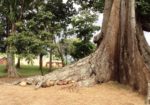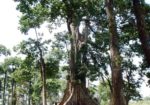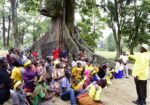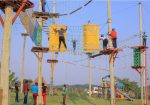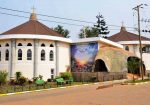The Nakayima Tree is supported by a large root buttresses, forming nooks and fissures. The root system has formed four spaces believed to be rooms each for Ddahula, Nalongo Jajja Mukasa, Jajja Musoke and Kilunda. The top of the hill has a flat table-like top which is believed to have been a fort for the Chwezi dynasty (1350 -1400) and an official residence of Nakayima, a Princess to Ndahura the last King of the empire. Once on the top of the hill one gets an excellent view of Mubende town and the surrounding area. The tree which is 40 meters high is estimated be 400-500 years old.
Nakayima Tree marks a shrine, of the spirits of Nakayima the first wife of the Bachwezi King Ndahura. The shrine is visited by people paying homage to Nakayima or Bachwezi dynasty. The believers offer sacrifices of coins, animals and other items to obtain favors of wealth, good health and others from the Bachwezi goddess, The Bachwezi were believed to possess supernatural powers. The tree is therefore believed to be the spiritual home for the Bachwezi goddess respected by both the Baganda and the Banyoro. Nakayima Shrine is also said to hold the spirit of Ndahura, a former Bachwezi king.
It’s claimed Nakayima wasn’t only a keeper of the tree, but was also a medium through which the spirit of Ndahura would communicate to the community. Nakayima is claimed to have had mystic powers that made her able to restore small pox victims to full health by treating them. She would also treat other diseases that wouldn’t be treated by any other herbalists around the community besides blessing barren women with children.
It is believed that the Nakayima lineage was acknowledged four centuries a spiritual figure to both the rulers and the peasantry of Buganda and Bunyoro. Its end was remarkably abrupt. The first intimation of its demise in 1888, when the religious conflict that rocked Buganda forced the incumbent nakayima, Nyanjara, to flee from Mubende. When she returned a year later, all but one of the seven huts traditionally in habited by the Nakayima razed, while the graves of her predecessors had been defaced, and her sacred drums had vanished. This attack had no immediate impact on the Nakayima’s influence in Bunyoro, then relatively un exposed to exotic religions-indeed, king Kabalega made a special visit to Mubende to pay Nyanjara tribute in 1899.
As early as 1902, the political autonomy that had characterized the once- feared and revered spiritual community led by the Nakayima was curtailed when Mubende Hill was placed under the indirect colonial rule of a Maganda Saza chief appointed by the British administration at Kakumiro. Nyanjara retired to Bugogo, where she died in 1907, the first Nakayima not to be interred in the traditional cemetery near the sacred tree, through eventually she was buried in isolation at the base of Mubende Hill. Her fantastic regalia, confiscated by the authorities now form one of the most impressive displays in the national museum in Kampala-together with two large and ancient pots.
Located on top of Mubende Hill along Kampala – Fort portal highway and approximately 3.8 kilometers from Mubende Town and 181 kilometers from Kampala




